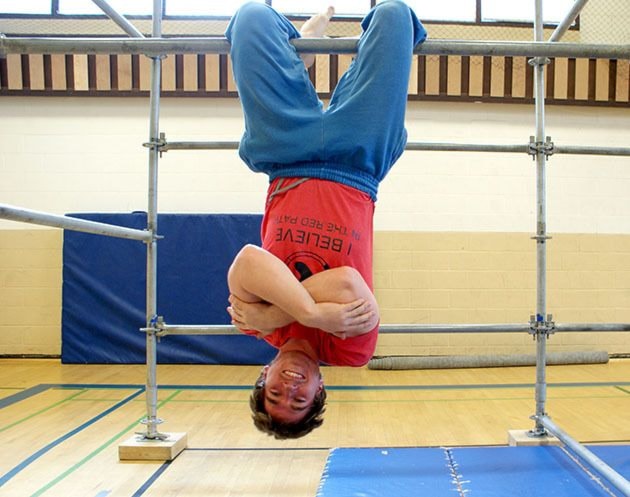Learning how to move like an action star begins by acting like a monkey.
Parkour teacher Mateus Dachwitz got down on all fours Wednesday and led his class of kids through what he called "Monkeying 101," which involved getting his pupils to use their hands and feet to move, swing and crawl quickly around a space.
This led, perhaps predictably, to some monkey business. But once the gorillas finished pounding their chests they used what Dachwitz taught them to climb around a scaffold with ease.
"What's very attractive about parkour is that almost superhuman feeling you get doing it," said Dachwitz. "You're doing these big leaps, big vaults, huge swings. You're doing flips and all kinds of other things. You know, it kind of gives you that real rush, too."
Dachwitz and Mike Garvey are co-owners of Red Path Movement, which holds parkour classes throughout West Kootenay. The pair have worked together for six years, having met in Nakusp while Garvey was a youth counsellor. Garvey had been trying to find ways to connect to the kids he was working with when one suggested parkour.
 The idea took hold, and a year later the fledgling program drew in Dachwitz, who had tired of team sports.
The idea took hold, and a year later the fledgling program drew in Dachwitz, who had tired of team sports.
"When I found parkour it really caught me," said Dachwitz. "Just swinging around, vaulting, moving, it felt like something was being fulfilled again that hockey wasn't doing for me at the time."
Parkour, which originates from French military training, focuses on the most efficient way of a person moving from one point to another. Pop culture loves parkour — prominent practitioner Sebastien Foucan made the activity look sensational as James Bond chased him in the opening scene of Casino Royale while the video game franchise Assassin's Creed uses parkour movements as the basis for its gameplay — and Dachwitz credited how parkour looks on screen with its rise in popularity.
Like anything, it takes practice before someone can traverse a city in style.
"With younger kids, a lot of times they come in and [say], 'I want to flip,'" said Garvey. "And there's a build-up process to getting there. They'll come in and say, 'Well I've done flips on my trampoline.' So part of it is just being able to slow down, work on the basics, build up the strength, all of the proper techniques, landings, etc., that's required to do it in the safest way possible."
Dachwitz and Garvey, neither of whom appear to be assassins, are an unusual paring. Dachwitz is just 22 but has thrown himself into parkour, having coached for a year in Calgary and completed a parkour certification in Regina. Garvey is 56, and came to parkour with 27 years experience as a fitness instructor and over two decades as a family, youth and addictions counsellor.
What unites them is a belief parkour can do more for its practitioners than just the ability to leap over railings.
 To that end, the pair use a medicine wheel in their classes. The wheel is an aboriginal symbol that can vary in its interpretations, but is broadly used as a spiritual and educational tool that can provide guidance. Dachwitz and Garvey use their own medicine wheel, formed of stones and sticks, to set goals for their students.
To that end, the pair use a medicine wheel in their classes. The wheel is an aboriginal symbol that can vary in its interpretations, but is broadly used as a spiritual and educational tool that can provide guidance. Dachwitz and Garvey use their own medicine wheel, formed of stones and sticks, to set goals for their students.
"We'll ask people what may be a real physical challenge that you can create for yourself in the setup," said Garvey, "and along the way they discover that it also touched their emotions because there was a fear that they had to do this or there was a decision they had to make they weren't quite ready for or they had to figure out how to make the movement smaller so they can make it possible and build it from there."
Incorporating First Nations teachings into parkour is what sets Dachwitz and Garvey apart from other practitioners — the name Red Path Movement is inspired by the red road, which is a way of positive living set out by the Creator.
Garvey is Cayuga, one of the Six Nations based in Southern Ontario. He works with the Circle of Indigenous Nations to support mental health and addictions recovery using traditional aboriginal techniques, and was asked at a conference a year ago if he could incorporate a medicine wheel into parkour.
Garvey obliged. Now his students begin and end each class sitting around the wheel.
"When you are looking at these areas," Garvey said as he pointed at the wheel, "they are aspects of all of us."
All Dachwitz and Garvey need now is a space of their own. They use a cube van to move equipment between Nakusp, New Denver, Salmo, Kaslo, Revelstoke and Nelson, but are trying to raise $35,000 through an Indiegogo campaign to open a gym in Nelson.
"We've travelled the valley over the course of the past couple years and we've realized that in the end if we want to make a more sustainable type of programming, we need to be in a larger community," said Garvey.
The demand is there. Dachwitz and Garvey already have 30 students split into two classes held every Wednesday at Selkirk College's Mary Hall gym. Nelson, they hope, will eventually be the centre of parkour in the Kootenays.
Or, at the very least, a good place for monkeys to swing.
